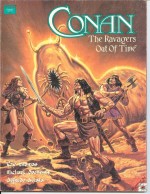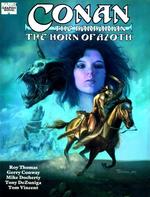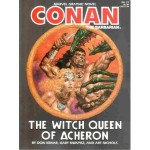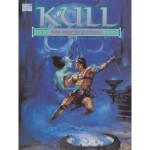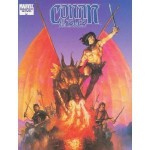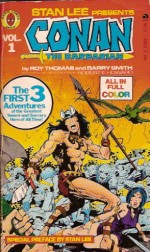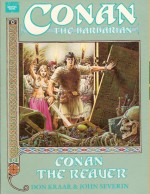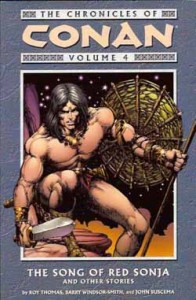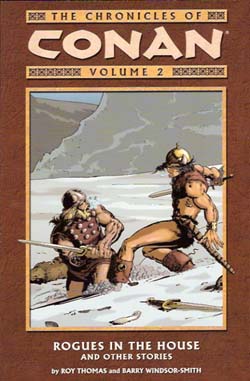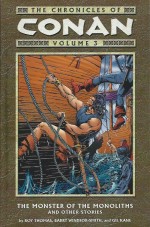
By Robert E. Howard, Roy Thomas, Barry Windsor-Smith, Gil Kane & various (Dark Horse Books)
ISBN: 978-1-59307-024-3
During the 1970’s the American comic book industry opened up after more than fifteen years of cautious and calcified publishing practises that had come about as a reaction to the censorious oversight of the self inflicted Comics Code Authority. This body was created to keep the publisher’s product wholesome after the industry suffered their very own McCarthy-style Witch-hunt during the 1950s.
One of the first genres revisited was Horror/Mystery comics and from that came the pulp masterpiece Conan the Cimmerian, via a little tale called ‘The Sword and the Sorcerers’ in anthology Chamber of Darkness #4 (April 1970), whose hero Starr the Slayer bore no little thematic resemblance to the Barbarian. It was written by Roy Thomas and drawn by Barry Smith, a recent Marvel find, and one who was just breaking out of the company’s still-prevalent Kirby house-style.
Despite some early teething problems – including being cancelled and reinstated in the same month – the comic-strip adventures of Robert E. Howard’s brawny warrior were as big a success as the revived prose paperbacks which had heralded a world flowering in tales of fantasy and the supernatural.
This third Dark Horse volume collects #14-15 and #17 through 21 of the monthly Marvel Conan the Barbarian comic-book, covering March to December 1972 (a period when the character was swiftly becoming the darling of the Comics world), and features two creators riding the crest of that creative wave.
Moreover the masterful storytelling is enhanced by a rich new colouring make-over that does much to enhance Smith’s ever-evolving intricate and meticulous art style, meaning work which was crafted for a much more primitive reproduction process is now full-bodied, substantial and beguilingly lush.
The fabulous fantasy opens with a tempestuous transatlantic team-up as Conan meets Michael Moorcock’s groundbreaking Elric of Melniboné in a two part tale freely adapted by Thomas, Smith & Sal Buscema from a treatment by the exceedingly English cult author and his frequent collaborator James Cawthorn.
Elric is a landmark of the Sword and Sorcery genre: last ruler of a pre-human civilization. The denizens of Melniboné are a race of cruel, arrogant sorcerers: dissolute creatures in a slow, decadent decline after millennia of dominance over the Earth.
An albino, Elric VIII, 428th Emperor of his line, is physically weak and of a brooding, philosophical temperament, caring for nothing save his beautiful cousin Cymoril, even though her brother Prince Yrrkoon openly lusts for her and his throne.
Elric doesn’t even really want to rule, but it is his duty, and he is the only one of his race to see the newly evolved race of Man as a threat to the Empire. He owns – or is possessed by – a black sword called Stormbringer: a magical blade which sucks out the souls of its victims and feeds their force and vitality to the albino.
His life is all blood and tragedy, exacerbated by his despised dependence on the black sword and his sworn allegiance to the chimerical Lord of Chaos Arioch…
Heady stuff for those simpler comicbook times: the White Wolf was the complete antithesis of roistering lusty, impetuous Conan, who was drawn into a trans-dimensional conflict when he rescued old associate Zephra from a pack of marauding Chaos Warriors in ‘A Sword Called Stormbringer!’
The comely wench was the daughter of Zukala: a wizard who strangely bore no animosity towards the barbarian youth who shattered his power and maimed his face the last time they clashed. In fact the mage wanted to hire Conan to stop rival wizard Kulan Gath from rousing a sleeping demon queen from another realm…
The promise of much gold convinces the normally magic-avoiding warrior to accept the commission and soon he and Zephra are riding hard for the lake beneath which Terhali of Melniboné lies, but they are unaware that Xiombarg, Queen of Swords (and rival Lord of Chaos) has despatched her own warriors to intercept them…
As they near the haunted mere the humans meet a gaunt, eerie albino with his own reasons for seeking out Terhali.
After a violent misunderstanding Conan and Elric call a suspicious truce, intent on stopping Kulan Gath, his patron Xiombarg and a small army of Chaos killers, but once the unlikely trio of world savers reach the submerged city of Yagala, they find that ‘The Green Empress of Melniboné!’ is wide awake and intent on making her own apocalyptic mark on the Hyborian Age…
It takes the callous intervention of Arkyn, Lord of Order and the willing sacrifice of Zephra to end the emerald menace and the heartsick heroes part; each riding towards his own foredoomed destiny…
As revealed in detail in Thomas’ informative ‘Behind the Swords’ Afterword, ‘The Gods of Bal-Sagoth’ was created after Barry Smith resigned – citing the punishing deadlines and poor reproduction values of the now monthly title – whereafter a frantic scrabble for a replacement happily brought forth avid RE Howard fan Gil Kane, who lent his galvanic dynamism to a stunning 2-part adaptation of a prose short story originally starring Celtic adventurer Black Turlogh O’Brien…
Inked by Ralph Reese the tale began as Conan clashed again with former foe and current pirate chief Fafnir, before the ship they rode in foundered in a storm.
The only survivors, Cimmerian and Vanirman washed ashore on a mist-enshrouded island and fell into a savage power struggle between ambitious castaway Kyrie – who claimed to be the incarnation of goddess Aala – and High Priest Gothan who ruled the oldest kingdom in the world through sorcery and his puppet king Ska…
Now the faux deity utilised an ancient prophecy concerning two warriors from the sea to make her play, but only slaughter and cataclysm awaited after the insurgency released ‘The Thing in the Temple’ (inked by Dan Adkins)…
Clearly refreshed and re-inspired, Smith returned with #19 to begin the magnum opus of the early Conan canon as the Cimmerian and Fafnir, only survivors of drowned Bal-Sagoth, were picked up and pressed into service with the invasion fleet of a power-hungry prince…
Developed and adapted from Howard’s lost historical classic The Shadow of the Vulture, the War of the Tarim was a bold epic that embroiled our young wanderer in a Holy War between the city-state of Makkalet and expansionist Empire of Turan, led by the ambitious Prince Yezdigerd, who would become a bitter, life-long enemy of our sword-wielding swashbuckler.
‘Hawks of the Sea’ opens slowly as the outlanders learn the ostensible reason for the conflict – the stealing of the current fleshly receptacle of the Living God Tarim – but soon kicks into high gear when Yezdigerd’s initial beachhead in Makkalet is repulsed by sorcery. Only Conan’s inimitable prowess and ingenuity allows the survivors to escape back to the relative safety of their ships…
In the next instalment the Cimmerian is part of a commando raid to steal back the man-god and meets a “temple-wench†who turns out to be the city-state’s embattled queen. However the mission goes bloodily awry when Machiavellian high priest Kharam-Akkad unleashes the citadel’s ‘Black Hound of Vengeance!’
Barely surviving the beast’s fury, Conan returns to Yezdigerd’s flagship where, upon discovering what the invaders have done with their own burdensome wounded, he maims the Turanian prince and jumps ship…
The story element of this epic volume ends with ‘The Monster of the Monoliths!’ (heroically inked by Adkins, P. Craig Russell, Val Mayerik & Sal Buscema) as Conan, at risk of his life, defects to the side of besieged Makkalet and is promptly commissioned by ineffectual King Eannatum to ride through the lines with a small company of men to seek allies and assistance amongst the Queen’s noble but distant family.
Little does he realise that’s he’s been designated a worthwhile and expendable sacrifice for an arcane antediluvian horror from beyond the mortal realms… but then again little does the loathsome travesty of nature understand the nature of the man it’s being offered…
Augmented by Thomas’s insightful observations and intriguing reminiscences, this rousing, evocative, beautiful and deeply satisfying collection is a superb slice of savage escapism that any red-blooded, action-starved armchair adventurer would kill for, and these re-mastered issues are a superb way to enjoy some of American comics’ most influential – and enjoyable – moments. They certainly deserve a prized place on your bookshelf.
©1972, 2003 Conan Properties International, LLC. All Rights Reserved.

